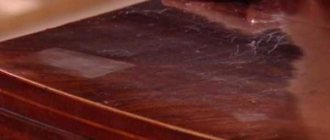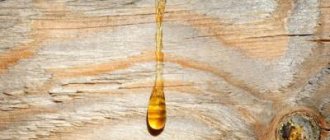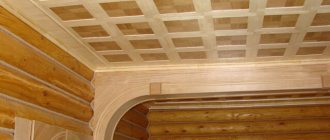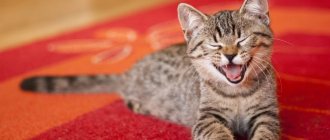What will you learn from the article?
- Causes of unpleasant odor
- How to remove the smell of cat urine Traditional methods
- What not to use
- Prevention measures
If your beloved pet really likes to mark any things in the apartment (car) (sofa, chairs, shoes, carpet), after which not only stains remain, but also an unpleasant smell of urine, then this article is especially for you. We will tell you how to remove the smell of cat urine at home.
Causes of odor
The smell emitted by cat urine is unusually persistent. Why does my cat's urine stink? The reason is the specific composition of this liquid:
- urochrome – coloring matter;
- urea, which gives a sticky consistency;
- uric acid, which accelerates the process of crystallization of secretions.
An unpleasant odor appears when urea decomposes with the help of bacteria. Decomposition products (thiols) smell even worse. When you try to use traditional detergents to remove "fragrance", only superficial traces are removed. Urine crystals are insoluble in water, so they remain on the surface and after a while the smell appears again.
Why does it smell like that?
Surely, you have asked the question “Why is the smell of cat urine so pungent and difficult to remove?” Everything is explained by the composition of these animal secretions:
- Urochrome is a substance that gives color.
- Urea is a substance that makes a puddle or stain sticky after drying.
- Uric (uric) acid - it is what helps the cat’s urine to quickly crystallize - these “crystals” do not dissolve in water, which is why it is difficult to get rid of the smell, and we are at a loss - how to remove the smell of cat urine?
Alas, the cat himself will not be able to remove the consequences of his “deeds.”
Thus, by simply thoroughly washing the affected area with water, you will only remove the first two components. The “crystals” will remain and will continue to “smell”, especially on surfaces that quickly and easily absorb moisture. Therefore, our struggle must first of all be directed against them.
Advice! If you are thinking about how to eliminate the smell of cat urine, then take decisive measures to eliminate such unpleasant behavior of the animal immediately after the first puddle you notice! And this does not mean at all that the cat needs to be severely punished; the reasons for his actions are most likely in your actions and in your attitude towards him.
The cat's litter box should always be clean - the animal may ignore a dirty litter box
Traditional methods of eliminating traces of urine
How to remove and neutralize the smell of a kitten at home? Over the centuries of coexistence between people and domestic cats, many ways have been invented to combat the unpleasant consequences of cat marks. Some of the remedies are quite radical and can change the color or texture of the furniture instead of destroying (eliminating) traces of ugliness. Therefore, before using it in an apartment, it is better to test the substance on the least visible area of the surface to be cleaned.
Potassium permanganate solution (potassium permanganate)
A solution of potassium permanganate reacts with ammonia molecules. The stench disappears, but the surface turns pink. The water-repellent coating must be immediately washed with clean water to remove excess potassium permanganate. If the surface absorbs moisture, the color will remain forever. When preparing a solution for removal, you must thoroughly stir the liquid to dissolve the raspberry crystals.
Vinegar
Prepare a solution of vinegar and water in a ratio of 1:2 and spray from a spray bottle onto problem areas. After such treatment, the surface should be washed, and the clothes should be washed and sent to the wash.
Lemon juice
Mix the juice of half the fruit with 100 ml of water and pour into a fragrant corner. It is not recommended to wash off, since the strong aroma of citrus fruits will not allow the cat to leave marks in the same place again.
Soda with hydrogen peroxide
This method has worked well for removing urine stains from carpets and upholstered furniture. Sprinkle a thick layer of baking soda powder onto the stain and pour in peroxide. Leave the mixture for 12 hours, then remove the remaining mixture with a cloth soaked in soapy water.
You can do it differently: mix 15 g of peroxide, 2 tbsp. l. soda powder and pour into a bottle with soap solution. Pour the mixture onto the stain, then rinse.
Iodine
Dilute 10 drops of iodine in 2 glasses of water. Wet the stain with the mixture, wait 3 hours, then rinse. This method is not suitable for light-colored coatings, since iodine has a coloring property.
Glycerin soap
To remove dirt from furniture upholstery, carefully treat the stained area with a moistened bar of soap. Then you should go over the dirt with a stiff brush, rinse and dry.
Laundry soap
Grate a bar of soap, add heated water, and stir. When the composition becomes homogeneous, rub the mixture into the marked area, wait half an hour and rinse with warm water.
Vodka
Trying to remove a urine stain or smell with vodka is useless. You can only discourage the cat from using this place as a toilet again, since alcohol stinks and cats can smell it a mile away. Other residents will also have to put up with the annoying aroma.
Soda plus salt
This method is recommended for cleaning rugs or sleeping areas. The stained area of the cat's mark is filled with soda and sprinkled with a layer of salt. Leave for 3-4 hours, then rinse thoroughly with warm water.
All of the above methods are suitable for eliminating fresh contamination. To eliminate old traces of cat litter, you will have to use a combination of these products or take the item to the dry cleaner.
Chemicals from pet stores
On the shelves of pet stores you will find a large selection of products designed to remove traces of cat dirty tricks. You can buy:
- the drug "Brovadez-plus", sold in the form of a dry powder, it will help you get rid of even persistent and ingrained odors;
- Nature's Miracle liquid mixture to remove old traces of cat urine;
- drug "OdorGon", etc.
Chemical products will help you quickly get rid of traces of cat urine and return your home to cleanliness and freshness.
Professional odor neutralizers
If it is not possible to remove the cat’s waste using a homemade method, you will have to use professional odor eliminators. The modern chemical industry produces a large list of products designed to completely eliminate unpleasant odors.
Shredder “8 in 1 NM advanced”
An effective product for removing old stains, including vomit, grass, urine and blood stains. Active oxygen and bio-enzymes included in the product guarantee complete cleaning and remove odors. The destroyer is recommended for use on carpets, cat litter boxes, soft and hard surfaces, and fabrics.
Dezosan
The composition, working at the molecular level, is designed to completely eliminate unpleasant odors. Recommended for use in washing vacuum cleaners.
Odor kill
After using this vanilla-smelling product, the aromas of burning, smoke, fur and pet feces will completely disappear from the air. Method of application: the drug is dissolved in water and sequential treatment of all coatings in the room, both hard and fleecy, is carried out. Per 100 sq. m. surface will need 1 liter of product.
Odor Gone
The herbal drug is produced at Russian enterprises under an American patent. Advantages:
- natural composition;
- disinfecting properties;
- no allergic effect;
- economical (up to 10 sprays of spray per room).
Thornell Cat Odor -off
After spraying the remover, the smell of urine and feces is completely eliminated, quickly replaced by a fresh aroma. The product can be applied to any coating.
Urine -off
Designed to completely neutralize uric acid crystals that cause unpleasant odors. The reaction products are completely harmless: water and carbon dioxide. The drug stabilizer also serves to block cat pheromones. This quality makes it possible to exclude that the cat will want to mark the treated area again. Urine-off does not contain allergens or toxic chemicals and is recommended for areas where small children live and in cars.
Chemical method of urine decomposition
How to remove and decompose cat urine at a chemical level? To eliminate foul-smelling traces of a cat's activity, you can use a recipe designed to remove the stench of skunk excretions. The urine of these animals contains protein compounds that serve as a source of discomfort for others. The process involves two stages: removal of uric acid, and then neutralization of thiols. Required ingredients: nine percent vinegar, soda, hydrogen peroxide and dishwashing liquid.
Procedure:
- 1) Remove moisture using paper napkins or cat litter.
- 2) Dilute vinegar with water in a ratio of 1:3. Pour the solution over the treated area and leave to dry. At this stage, urine is destroyed.
- 3) After the vinegar has completely evaporated, lightly sprinkle the stain with baking soda powder and immediately proceed to the next step.
- 4) Combine hydrogen peroxide with an equal amount of water, add a teaspoon of liquid dish soap. Spray the mixture over a surface sprinkled with baking soda until foam appears. Wait for the reaction results (2-3 hours). The chemical reaction serves to produce oxygen, which neutralizes the thiols. Liquid soap is used to create foam that traps oxygen in the dirty area.
- 5) Remove dry mixture residues using a vacuum cleaner.
Using this method to eliminate odor is not only effective, but also does not require large expenses, since all components are inexpensive. The method can be widely used for cleaning entrances, elevators and other public areas. To remove old, stubborn dirt, pre-treatment with enzymes is recommended. A day after cleaning, you should treat the stain with vinegar, and another day later - with a mixture of soda and peroxide.
The vinegar in the recipe can be replaced with ethyl or isopropyl alcohol, but these substances are very toxic and can cause serious poisoning.
Find the source
It happens that a pungent odor does not allow a person to breathe normally, and the place of its origin cannot be determined. In this case, invisible contamination can be detected using ultraviolet radiation. Flashlights with ultraviolet lamps can be purchased at hardware stores or purchased at a pet store.
The search principle is simple: first turn off the lights in the room, then turn on the flashlight and walk along the surfaces, paying special attention to hard-to-reach places.
Important!
When ultraviolet light is emitted, the contamination begins to glow yellow or green.
Cleaning various surfaces
In order not to spoil the material during cleaning, before using the cleaning composition, you need to check the reaction on a small area of the coating.
Sofas, armchairs
For fabric coverings, the best solution would be potassium permanganate (for dark colors), vinegar solution or lemon juice.
Laminate, linoleum, parquet
Wipe the surface with a solution of vinegar or lemon juice, leaving the floor damp. After an hour, you can remove any remaining moisture by wiping the floor dry.
Bed
It is recommended to remove stains from mattresses, blankets and bed linen using sparkling water and salt. After pouring water and adding a layer of salt, wait 2-3 hours, then wash off the residue.
Shoes, sneakers
Is it possible to wash cat piss off shoes? Tags on shoes are the most difficult to remove. If the marks are fresh, you should try to get rid of moisture by placing napkins or newspaper inside the shoes, and then wash the shoes with laundry soap.
If the mark has already become old, it is recommended to repeat the washing procedure several times, and then wipe the shoes with a vinegar solution. Fabric shoes can be washed in a washing machine. If your boots continue to smell unpleasant, it is better to buy an odor neutralizer from a pet pharmacy.
Carpet
The general rule that a fresh tag is easier to remove also applies in this case. You can use a solution of vinegar, lemon juice or laundry soap. It is recommended to pour vinegar over old stains and cover them with baking soda powder.
Cloth
It is better to simply wash and rinse soiled clothes, jackets, and stains in a weak vinegar solution.
Wooden furniture
Cover the stain with an even layer of baking soda. Wait 40 minutes, then remove the residue and spread the surface with laundry soap. To enhance the effect, the soap must first be grated and soaked.
House plants
Plants are treated by watering. Add an activated carbon tablet to 1 liter of water.
Precautionary measures
Frequent use of cleaning liquids containing chlorine can negatively affect the well-being of people and animals.
Vinegar and lemon solutions greatly dry out the surfaces being treated. After such treatment, the leather may crack and dry out, so it is recommended to use special products for the care of shoes or leather upholstery.
Coatings with a large number of pores (wood, concrete) require repeated treatment and pre-soaking with vinegar solution. During major repairs, it is recommended to burn the concrete floors using a blowtorch.
Fabrics that have been cleaned with peroxide should be washed with the addition of 100-150 ml of apple cider vinegar.
What not to use
Steam generator. Water vapor can only make the situation worse because it does not eliminate the unpleasant odor, but intensifies it. After using the steam generator, the stain becomes more noticeable and the smell becomes stronger.
Preparations containing ammonia. Some cleaning products contain ammonium salts or ammonia. These compounds do an excellent job of removing grease and limescale, but they are powerless against cat urine. All nitrogen-containing substances have a specific odor, similar to the aroma of urine, which can mislead the cat.
Chlorine-containing products . Firstly, it is unsafe for the health of people and animals, and secondly, chlorine tends to enhance odors. Because it reacts chemically with urea.
Substances that mask odor. These are air fresheners, fragrances, deodorants, aromatic oils, coffee beans, etc. Yes, this can camouflage an unpleasant odor, but it is impossible to deceive the sense of smell of animals, so they will again return to where they once “made a puddle.”
Common Misconceptions
One of the common mistakes that owners of furry pets make is punishment without clarifying the circumstances. A cat may mark territory for the following reasons:
- stressful state;
- urinary system disease;
- tail injury;
- uncomfortable tray;
- poor selection of toilet filler.
The second most common mistake is the decision to postpone cleaning until a more favorable time. A fresh stain is much easier to remove, but old urine residue will attract the cat to repeat the violation again.
The third misconception is related to the second and is to get rid of the smell at any cost. The use of deodorants and fragrances (coffee, aromatic oils, incense) relieves the human nose from suffering, but the cat will still feel its marks and will get used to using the marked area of the home space for the toilet.
Chlorine-based products disinfect well, but the stench only intensifies after such cleaning.
Prevention of the problem
It is easier to eliminate any problem than to deal with its consequences like “how to neutralize the smell of cat urine.” Therefore, if this is not the first time your pet has ignored its litter box, you need to find the reason for this behavior. Let's look at what it turns out to be most often:
- Your cat simply doesn’t like his litter box and is behaving this way on purpose. Hostility can arise due to many circumstances - the cat’s litter box is too small for its owner (the litter box should be twice the size of the cat sitting in it), the cat cannot have privacy during the process (passage place, nearby toilets of other cats), the animal does not have the opportunity to bury their excrement (this is especially typical for cats who, from childhood, go to a tray with filler and sand).
- The animal discovered an unfamiliar thing with a “foreign” smell. Usually this is the property of the owner’s guests - bags, clothes, shoes. Therefore, in the future, out of harm’s way, put the things of those who come to visit you in the closet.
What's happening to your cat could be a symptom of a serious illness
- The animal is seriously ill or is in a stressful situation. If a cat has cystitis or urolithiasis, then she simply cannot control the process of urination. And “finished” things, furniture, are just the tip of the iceberg. It is possible that the disease seriously threatens the health and life of the animal, and it urgently needs the help of a veterinarian. Also, a cat may urinate in the wrong places, experiencing extreme stress - the animal is very frightened, is in an unfamiliar and incomprehensible situation or environment, there are many strangers around it, it hears sounds that are scary for it, etc.
- This is how the cat marks its territory. This is typical for uncastrated animals. To avoid taking your animal for surgery, try letting him go for walks in the fresh air (if you are afraid that the cat will get lost, accompany him by putting a leash or harness on the animal). Some owners recommend a zoopsychological method - to catch the animal at the scene of the crime, take it by the scruff of the neck and menacingly, without blinking, look into its eyes. Whoever wins this “staring contest” and does not take his eyes off first, will be the founder of order in the house. There is also such a strange way: to wipe the place of the cat's mark after cleaning with your sweaty thing.
The main thing is to raise the animal correctly
- A cat is a very clean animal. And such indecent behavior may be a direct protest to the fact that her tray is completely unsanitary. Try to clean the cat litter box on time, using disinfectants and odor-eliminating products.
- Sometimes such puddles can be a kind of revenge for old grievances. If you hit the cat and try to isolate it, you will only make the situation worse.
Don’t forget about this universal remedy.
We hope that our article helped you determine how to remove the smell of cat urine from various surfaces using improvised or professional means. Let us remind you once again that with frequent repetitions of such incidents, it is much more important to eliminate the reason that caused this behavior of the animal.
Tips for renovation
The presence of pets in the home imposes additional obligations on owners. Compliance with a number of requirements when renovating a home will help the animal owner to significantly simplify the life of himself and his charges.
When arranging the floor, fleecy coverings should be avoided. It is impossible to properly clean such surfaces, so the carpet floor will always serve as a source of dirt and infection.
Laminate looks no worse than parquet, but urine easily gets into the holes between the boards, promoting rot. Wooden or varnished parquet floors are much more hygienic.
When laying baseboards, you should carefully seal the joints, leaving no holes between the floor and walls. It is recommended to lay an insulating film on top of concrete floors to prevent the concrete from getting wet.
When choosing linoleum, you should give preference to a material with a waterproof synthetic lining.
Tile or ceramic tiles should only be attached with an adhesive base. Using the solution creates cavities into which urine can leak through the seams between the tiles. For high-quality sealing of seams, you need to use a polymer-based grout to protect against corrosion by uric acid.
The best choice for a home with cats and dogs would be epoxy self-leveling floors.
Cleaning the house will be greatly facilitated if the lower part of the walls is painted with paints that can be washed using brushes and chemicals. It is not recommended to use paper and fabric wallpaper. The plaster should also be checked for acid resistance before installation.
For cleaning, it is recommended to use a water vacuum cleaner.
Preventive measures
The urine of warm-blooded animals contains protein processing products. After leaving the body, these substances become a breeding ground for bacteria. This process causes an unpleasant odor and a source of infection.
To stop the appearance of puddles of urine in secluded places at home, the pet owner should pay attention to the possible causes of unwanted behavior:
- The cat is unhappy with the tray. Perhaps the animal does not like the configuration of the tray or the owner does not bother himself too much with the timely replacement of the filler.
- An annoying person or piece of furniture has appeared in the house. When marking territory, the cat exhibits a defensive reaction.
- Old age or illness. If your pet did not suffer from such abnormalities as a child, you should take the cat to a veterinarian for a diagnosis.
- Tail injury often interferes with the natural fulfillment of needs.
- Sexual activity. An animal that is not subject to mating must be sterilized or neutered.
- The tray is located in an inconvenient place. Cats generally prefer quiet corners away from light.
- Not enough trays. If there are several pets, the number of toilets should be increased.
- Increased love for cleanliness. Some cats separate litter boxes for large and small needs. Installing a second tray will help solve the problem.
To prevent problems from reoccurring after removal of contamination, it is recommended:
- Treat surfaces using proprietary preparations from a veterinary pharmacy.
- Scatter the peels of oranges or tangerines. The smell of essential oils will repel your pet.
- Place vials with ground pepper or coffee in the marked places, having previously drilled the lids.
- If the cause of the problem is heat, the pet should be sterilized.











